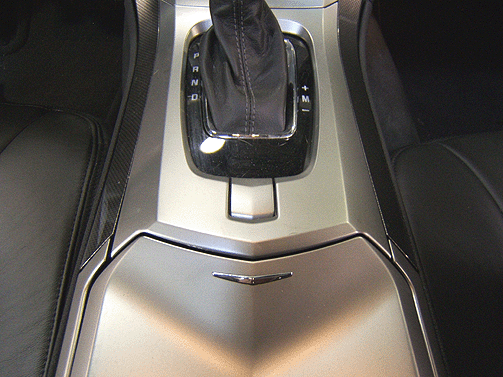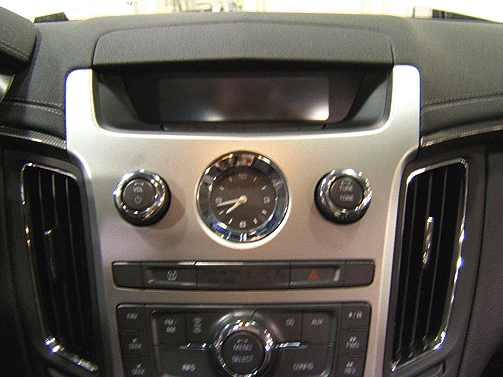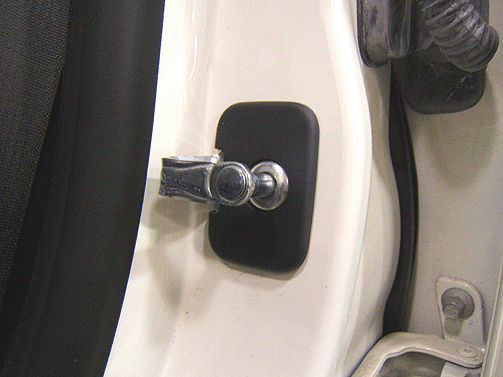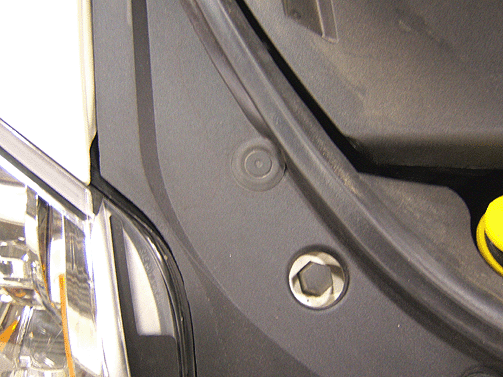CTS - New Model Features and Service Guide

| Subject: | CTS -- New Model Features and Service Guide |
| Models: | 2008 Cadillac CTS |
This is a special bulletin to introduce the new 2008 Cadillac CTS. The purpose of this bulletin is to familiarize dealership service personnel with the vehicle's features and describe the actions the Service Department will need to take to ensure they are able to fully service this exciting new model.
ABOUT THE VEHICLE
The purpose of this section is to familiarize you with the technical aspects of the vehicle.
Engine
The 2008 CTS comes standard with a 3.6L VVT DOHC V6 engine (RPO LY7 - VIN Code 7) with 263 hp and 253 lb-ft of torque. Also available is a 3.6L Direct Injection (DI) VVT DOHC V6 engine (RPO LLT - VIN Code V) with 304 hp and 273 lb-ft of torque.
Transmission
Both engines can be mated to either a standard six-speed manual transmission or an optional Hydra-Matic 6L50 six-speed automatic transmission.
Brakes
The 2008 CTS is equipped with larger diameter four-wheel vented disc brakes as well as standard four-wheel antilock braking system (ABS) and traction control system (TCS), all which contribute to exceptional stopping power. Additionally, Hydraulic Brake Assist senses emergency stopping situations and boosts the power applied to the brakes.
Suspension
The 2008 CTS is equipped with independent short long arm (SLA) front suspension and full independent multi-link rear suspension. Three suspension levels are available:
| • | FE1 tuned to get around town comfortably (RWD or AWD) |
| • | FE2 tuned for comfort and performance driving (RWD or AWD) |
| • | FE3 tuned for high-performance driving (RWD) |
Ultrasonic Rear Parking Assist (URPA)
URPA is designed to assist the driver in parking the vehicle. It will only operate at speeds less then 8 km/h (5 mph). The system will detect objects that are at least 254 mm (10 in) off the ground and below the trunk level. The system will detect objects up to 2.5 m (8 ft) in back of the vehicle. The rear park assist display is mounted in the center of the headliner at the rear window.
If the URPA system will not activate due to a temporary condition, the message PARKING ASSIST OFF will be displayed on the DIC and a red light will be shown on the rear URPA display when the shift lever is moved into REVERSE. The following conditions will set the PARKING ASSIST OFF message:
| • | The driver disables the system through the DIC. |
| • | The parking brake pedal is depressed. |
| • | A trailer is attached to the vehicle or an object is hanging out of the trunk when the vehicle was last turned off. |
| • | The sensors are not kept clean. |
Electrical Architecture
The communication among control modules is performed through the GMLAN high speed serial data circuit and the GMLAN low speed serial data circuit. The modules that need real time communication are attached to the high speed GMLAN network. The body control module (BCM) is the gateway between the networks. The purpose of the gateway is to translate serial data messages between the GMLAN high speed bus and the GMLAN low speed bus.
The body control module (BCM) is wired to the GMLAN High Speed serial data bus and the GMLAN Low Speed serial data bus, as well as discrete input and output terminals to control the functions of the vehicles body systems. The body control module is the translator between the High and Low speed GMLAN busses. The two communication protocols use the BCM to translate communicated serial data messages between the control modules over the two serial data busses. The body control module functions as the power mode master (PMM). The Power Mode Master (PMM) determines which power mode (Run, Accessory, Crank, RAP, or Off) is active and reports this information to other modules.
Refer to Control Module References in SI for a complete list of control modules and data link types.
Charging System Description and Operation
The 2008 CTS is equipped with an electrical power management (EPM) system which monitors and controls the charging system and sends diagnostic messages to alert the driver of possible problems with the generator or the battery. The EPM function is designed to perform regulated voltage control (RVC) to improve battery state of charge, battery life and fuel economy. The BCM communicates with the ECM and the IPC for electrical power management operation. The EPM system performs three functions:
| • | It monitors the battery voltage and estimates the battery condition. |
| • | It takes corrective actions by boosting idle speeds and adjusting the regulated voltage. |
| • | It performs diagnostics and driver notification. |
The electrical power management system consists of the following components:
| • | Generator |
| • | BCM -- communicates with the ECM and the IPC. The BCM determines the output of the generator and sends the information to the ECM for control of the generator field control circuit. It also monitors the battery current sensor, the battery positive voltage circuit, and the estimate battery temperature to determine battery state of charge. |
| • | Battery Current Sensor -- is connected to the negative battery cable. It monitors the battery current and directly inputs to the BCM. |
| • | ECM -- directly controls the generator field control circuit input to the generator. It monitors the generator's field duty cycle signal circuit and sends the information to the BCM. |
| • | IPC -- provides the customer notification in case a concern with the charging system. There are two means of notification, a charge indicator and a driver information center (DIC) message of SERVICE BATTERY CHARGING SYSTEM. |
The purpose of the charging system is to maintain the battery charge and vehicle loads. There are 6 modes of operation and they include:
| • | Battery Sulfation Mode |
| • | Charge Mode |
| • | Fuel Economy Mode |
| • | Headlamp Mode |
| • | Start Up Mode |
| • | Voltage Reduction Mode |
Keyless Access System (with RPO Y41)
Passive keyless access allows entry to a locked vehicle without pressing any buttons on the keyless entry transmitter. You must only have the transmitter with you. This passive system is also part of the vehicle starting system. It allows you to start and run the vehicle having only the transmitter as your key. The passive access and starting system use low frequency antennas in 4 different areas on the vehicle to determine the location of the transmitter. When passively opening a locked door or the rear compartment lid, you must have a programmed transmitter with you in your pocket, purse, or briefcase. As a customer opens the door handle or presses rear compartment touch pad, the low frequency antenna sends out a challenge to the keyless entry transmitter. The transmitter must be in a one meter range of the door or rear compartment lid in order to receive the challenge. If the challenge is met, the transmitter will respond, allowing the door to be unlocked and opened. Passive entry allows you to operate the following features:
| • | Passive door unlock/unlatch |
| • | Passive rear compartment lid release |
| • | Illuminated entry lamps |
| • | Vehicle starting |
The keyless entry system has the following components:
| • | Keyless access transmitters |
| • | LH and RH door antennas (part of the door handle assembly) |
| • | Rear compartment antenna |
| • | Console passive antenna |
| • | Console active antenna |
| • | Body Control Module (BCM) |
| • | Remote Control Door Lock Receiver (RCDLR) |
Heated Windshield Washer Fluid
If equipped, the heated windshield washer fluid system may be used to help clear the windshield. Push the heated washer fluid button (located on the climate control system panel) to begin four heated wash/wipe cycles. Heating Washer Fluid Wash Wipes Pending displays on the DIC. The first heated wash/wipe cycle may take up to 40 seconds to occur, depending on the outside temperature. After the first wash/wipe cycle. it may take up to 20 seconds for each of the remaining cycles. The heated windshield washer fluid system may be turned off at any time by pressing the button again. Heated Washer Fluid System Off displays on the DIC. It automatically turns off after four wipe cycles have been completed.
When the heated windshield washer fluid system is activated under certain outside temperature conditions, steam might flow out of the washer nozzles for a short period of time before washer fluid is sprayed. This is a normal condition.
Adaptive Forward Lighting System (AFL)
The Adaptive Forward Lighting System (AFL) swivels the headlamps horizontally to provide greater road illumination while turning. AFL will operate when the vehicle speed is greater than 2 mph (3 km/h). AFL will not operate when the transmission is in REVERSE (R). AFL is not immediately operable after starting the vehicle; driving a short distance is required to calibrate the AFL. To enable AFL, set the exterior lamp switch on the multifunction lever to the AUTO position. Moving the switch out of the AUTO position will deactivate the system.
Audio Mute/Voice Recognition Button
Press and release this button to silence the vehicle speakers only. The audio of the wireless and wired headphones, if the vehicle has these features, does not mute. Press and release this button again, to turn the sound on. If the vehicle has the navigation system, press and hold this button for longer than one second to initiate speech recognition. If the vehicle has OnStar®, press and hold this button for longer than one second to interact with the OnStar® system. If the vehicle has OnStar® and the navigation system, press and hold this button for longer than one second to initiate speech recognition and say "OnStar" to enter OnStar® mode.
Tilt/Telescoping Steering Wheel
In addition to the power tilt/telescope optional column, the standard manual column now telescopes as well as tilts when the lock lever is released.
Express Windows
All four windows have the express down feature. The front two windows also have the express up feature. Pull the switch up to the second position to activate this feature. Pull up again or press down on the switch briefly to stop the window.
Hard Disk Drive (HDD) System
The 2008 CTS has an optional 40 gigabyte hard drive that allows many functional uses of entertainment storage and interface with iPod and MP3 players. On navigation equipped vehicles, the mapping data is stored on this drive which utilizes approximately 30 gig of the space. Other utility software such as the Gracenotes® music librarian will also occupy some storage memory and therefore the entire 40 gigabyte area is not available. A special iPod cable is necessary to have complete interactive function between the iPod and the radio/steering wheel controls. Initially this cable will be sent out through a fulfillment process and then when production stock becomes available, it will be included in the vehicle.
Spare Tire (RPO ZAA)*
The 2008 CTS comes standard with a inflator kit. A compact spare tire is available and must be selected when ordering or purchased at time of delivery.
Inflator Kit*
It is estimated that the majority of the 2008 CTS built will have an inflator kit instead of a spare tire. It will be important for Cadillac Roadside technicians to know if the vehicle has the optional spare or the standard inflator kit when dispatched for flat tire calls. Proceed with caution reading all instructions & information regarding inflator operation. The compressor comes packaged with the sealant ready to install so if the unit is plugged in with the switch in the on position, sealant will immediately start to flow. If the operator wishes just to have compressed air, the nozzle must be detached from the sealant canister first.
* In Canada, the 2008 CTS comes standard with a compact spare tire instead of the inflator kit.
UNIQUE VEHICLE CHARACTERISTICS
The purpose of this section is to familiarize you with some of the unique characteristics of the vehicle. The following functions may operate differently than what the customers are used to and are considered normal.
Sunroof Controls
The 2008 CTS has express sunroof controls for the open/close functions of the power roof and shade. They perform differently from the express feature of the door windows. To activate the express feature, you must quickly press and release the button. If there is a delay in the release of the button, it will immediately stop in its position.
Rear Door Harness Grommet
The rear door wire harness grommet is impregnated with a wax for ease of assembly. This wax will continue to migrate out of the material over time and can never be completely eliminated. It offers no harm other than a possible undesired appearance.
Console Shifter Trim Plate

The trim plate contains a provision for a future feature that in its current state is just a styling cue and serves no functional purpose. It appears to be a button at the base of the shifter.
Radio Display Visor

The visor above the radio display is functional only on the navigation radio. It is controlled by a button on the center stack of the instrument panel. On non-navigation radios, the visor is still present but non-functional.
High Intensity Discharge (HID) Lighting
If a HID headlamp bulb has been replaced, the beam may be a slightly different shade than it was originally or compared to the other headlamp. This is a normal characteristic.
AVAILABLE PRODUCT TRAINING
Course # | Course Name |
|---|---|
10207.50W (U.S.) | 2008 Cadillac CTS New Model Features |
50525.01W (Canada) | What's New - 2008 Cadillac CTS |
SPECIAL TOOLS
The following new tools have been released for the 2008 Cadillac CTS:
Tool # | Description |
|---|---|
DT-48371 | Transfer Case Oil Fill Plug Wrench |
DT-48553 | Clutch Pack Measurement Adapter |
J-28467-550 | Engine Support Fixture Adapter |
DT-48636 | Flange Holder |
DT-48846 | Input Seal Installer |
DT-48847 | Pinion Flange Holding Fixture |
CH-48888 | PS Analyzer Adapter |
QUALITY PRE-DELIVERY INSPECTION (PDI)
The PDI form was revised to ensure special attention is paid to the areas listed below. For Dealers in Canada, the PDI form is available for download from the "GM World of Warranty" on the GMinfoNET.
Under Hood Side Shields
Under hood side shields have been added to the 2008 CTS engine compartment and proper installation sequence is essential to retention and hood sealing. Start at tower-to-tower brace and work forward. Clip rear edges under tower-to-tower brace. Tuck outer edges under hood seal.
Door Striker Covers

These are new to the CTS and to be installed during PDI. They are with the loose ship items in the rear compartment.
Headlamp Adjuster Cap Plugs

Cap plugs for the headlamp adjuster access holes are included in the loose ship items in the rear compartment and must be installed during PDI.
Owner Manual Storage
Owner manual storage on the 2008 CTS has been moved from the glove box to a storage pouch in the trunk. The pouch is held in place with hook & loop fastener and to be installed and/or checked for secured installation during PDI.
Front Air Dam
The front air dam cannot be installed in the assembly plant because of clearance restrictions during transportation. The installation is included in PDI and the parts are with the loose ship items in the trunk.
Battery
The battery is now located in the rear compartment in the right quarter panel area & has quick-release lever-lock terminal attachments. During PDI, verify that both battery terminals are fully seated to the bottom of the terminal post and that both clamps are locked. Vehicles that will not be placed into service within 20 days will require negative battery terminal disconnect.
